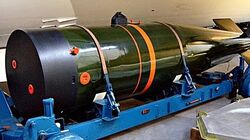
Worlds Top 5 Nuclear Power Comparison 2015.
Worlds Top 5 Nuclear Power Comparison 2015.
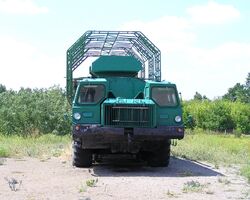
A Soviet SS-20 nuke and launcher truck.
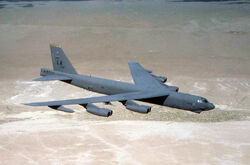
A B-52 bomber.
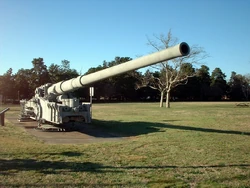
The Anomic Annie nuclear artillery peace.
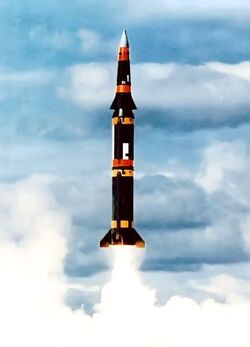
The US launching a Pershing II missile.
Overview
The phenomena
A nuclear holocaust or nuclear apocalypse would be a possible complete or nearly complete annihilation of human life through the use of nuclear weapons. Under such a scenario, all or most of the Earth is made uninhabitable by nuclear warfare in future world wars after a mass exstange of nukes in the war!
The term "Holocaust" and "Nuclear".
The English word "holocaust", derived from the Greek language's term "holokaustos" meaning "completely burnt", is commonly defined as "a great destruction resulting in the extensive loss of life, especially by fire."
The English word "holocaust", derived from the Latin language's term "nucleus" meaning "kernel", from nucula, little nut, diminutive of nux, nuc-, "nut". In this case it is relating to weapons, or the use of weapons, which use the power produced when the nucleus of an atom is divided or joined to another nucleus (nuclear weapon\nuke).
The difference between the different types of nuclear weapons (nukes)
- Atomic\Atom\A-bombs-
- Cobalt\Co-bombs- A cobalt bomb is a theoretical type of "salted bomb": a nuclear weapon designed to produce enhanced amounts of radioactive fallout, intended to contaminate a large area with radioactive material. The concept of a cobalt bomb was originally described in a radio program by physicist Leó Szilárd on February 26, 1950. His intent was not to propose that such a weapon be built, but to show that nuclear weapon technology would soon reach the point where it could end human life on Earth, a doomsday device. Such "salted" weapons were requested by the U.S. Air Force and seriously investigated, but not deployed. In the 1964 edition of the DOD/AEC book The Effects of Nuclear Weapons, a new section titled radiological warfare clarified the "Doomsday device" issue. Samuel Glasstone, The Effects of Nuclear Weapons, 1962, Revised 1964, U.S. Dept of Defense and U.S. Dept of Energy, pp.464–5. This section was removed from later editions, but, according to Glasstone in 1978, not because it was inaccurate or because the weapons had changed.
- Radiological device\R-bomb\RRD\dirty bomb\D-bomb-A dirty bomb or radiological dispersal device is a theoretical radiological weapon that combines radioactive material with conventional explosives. A conventional explosive tied to some atomic waste, atomic fuel, a hospital radio-therapy unit, a deactivated atomic warhead or a similar sort of thing. The blast scatters the radioactive part around a large location with out a fissile atomic blast.
- Neutron\N-bombs-
- Thermonuclear\T-bomb\Hydrogen\H-bombs- A hydrogen bomb or H-bomb, weapon deriving a large portion of its energy from the nuclear fusion of hydrogen isotopes. In an atomic bomb, uranium or plutonium is split into lighter elements that together weigh less than the original atoms, the remainder of the mass appearing as energy. Unlike this fission bomb, the hydrogen bomb functions by the fusion, or joining together, of lighter elements into heavier elements. The end product again weighs less than its components, the difference once more appearing as energy. Because extremely high temperatures are required in order to initiate fusion reactions, the hydrogen bomb is also known as a thermonuclear bomb. A thermonuclear weapon is a nuclear weapon that uses the energy from a primary nuclear fission reaction to compress and ignite a secondary nuclear fusion reaction. The result is greatly increased explosive power when compared to single-stage fission weapons. It is colloquially referred to as a hydrogen bomb or H-bomb because it employs fusion of isotopes of hydrogen. The fission stage in such weapons is required to cause the fusion that occurs in thermonuclear weapons. The misleading term "hydrogen bomb" was already in wide public use before fission product fallout from the Castle Bravo test in 1954 revealed the extent to which the design relies on fission.
- Helium\He-bomb-
- Electron\EM-bomb\EMP-bomb\EMP-device\E-bomb-
- Salted bombs- A salted bomb should not be confused with a dirty bomb, which is an ordinary chemical explosive bomb containing radioactive material which is spread over the area when the bomb explodes. A salted bomb is able by desinge to contaminate a much larger area than a dirty bomb.
The difference between the different types of detonation
- Surface\land\landbourne\conventional discharge burst-
- Air\sky burst\above surface\in the air\airborne-
- Terrorist weapon\nuke\atomic device detonation\incident-
- Sea/marine/nortical/ocean burst/below water/sub-marine/seabourne-
- Subterranean\sub-surface\beneath-surface\beneath the ground\mineshaft\mine-works\underground\buried burst-
The difference between delivery systems
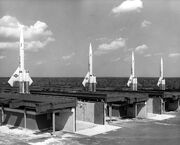
Bowmark anti-aircraft nukes.
- Dumb\unguided bomb- A bomb.
- Warhead- A SAM, ICBM, MRBM or torpedo's warhead.
- Shell- An artillery shell.
- Mine- A land or sea mine.
- Torpedo- A torpedo.
- SAM missile- A SAM missile.
- ICBM missile-
- MRBM\IRBM missile-
- Cruse missile-
Results

The Castle Bravo test blast.
Death and destruction par-sea
Electro magnetic pulse
Epidemics, starvation and famine
Radiation and ionizing radiation par-sea
Neutron radiation, alpha radiation, and extremely energetic gamma (> ~20 MeV) can cause nuclear transmutation and induced radioactivity. The relevant mechanisms are neutron activation, alpha absorption, and photodisintegration. A large enough number of transmutations can change macroscopic properties and cause targets to become radioactive themselves, even after the original source is removed.
On living things and people
In general, ionizing radiation is harmful and potentially lethal to living beings but can have health benefits in radiation therapy for the treatment of cancer and thyrotoxicosis.
Most adverse health effects of radiation exposure may be grouped in two general categories:
- deterministic effects (harmful tissue reactions) due in large part to the killing/ malfunction of cells following high doses; and
- stochastic effects, i.e., cancer and heritable effects involving either cancer development in exposed individuals owing to mutation of somatic cells or heritable disease in their offspring owing to mutation of reproductive (germ) cells.
Its most common impact is the stochastic radiation-induced cancer with a latent period of years or decades after exposure. The mechanism by which this occurs is well understood, but quantitative models predicting the level of risk remain controversial. The most widely accepted model posits that the incidence of cancers due to ionizing radiation increases linearly with effective radiation dose at a rate of 5.5% per sievert. If this Linear no-threshold model is correct, then natural background radiation is the most hazardous source of radiation to general public health, followed by medical imaging as a close second. Other stochastic effects of ionizing radiation are teratogenesis, Radiation-induced cognitive decline ad dementure, and heart disease.
On objects
Radiation may affect materials and devices in deleterious ways:
- By causing the materials to induced in to becomeing radioactive (mainly by neutron activation, or in presence of high-energy gamma radiation by photodisintegration).
- By nuclear transmutation of the elements within the material including, for example, the production of Hydrogen and Helium which can in turn alter the mechanical properties of the materials and cause swelling and embrittlement.
- By radiolysis (breaking chemical bonds) within the material, which can weaken it, cause it to swell, polymerize, promote corrosion, cause belittlements, promote cracking or otherwise change its desirable mechanical, optical, or electronic properties.
- By formation of reactive compounds, affecting other materials (e.g. ozone cracking by ozone formed by ionization of air).
- By ionization, causing electrical breakdown, particularly in semiconductors employed in electronic equipment, with subsequent currents introducing operation errors or even permanently damaging the devices. Devices intended for high radiation environments such as the nuclear industry and extra atmospheric (space) applications may be made radiation hard with heavy shielding to resist such effects through design, material selection, and fabrication methods.
Many of the radiation effects on materials are produced by collision cascades and covered by radiation chemistry.
On gases and water
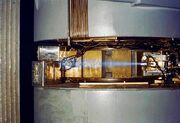
Ionized air glows blue around a beam of particulate ionizing radiation from a American cyclotron in 1939.
When water subjected to ionizing radiation forms free radicals of hydrogen and hydroxyl, which can recombine to form gaseous hydrogen, oxygen, hydrogen peroxide, hydroxyl radicals, and peroxide radicals. In living organisms, which are composed mostly of water, majority of the damage is caused by the reactive oxygen species, free radicals produced from water. The free radicals attack the biomolecules forming structures within the cells, causing oxidative stress (a cumulative damage which may be significant enough to cause the cell death, or may cause DNA damage possibly leading to cancer).
Exposure to radiation causes chemical changes in gases. The least susceptible to damage are noble gases, where the major concern is the nuclear transmutation with follow-up chemical reactions of the nuclear reaction products.
High-intensity ionizing radiation in air can produce a visible ionized air glow of telltale bluish-purplish color. The glow can be observed e.g. during criticality accidents, around mushroom clouds shortly after a nuclear explosion, or inside of a damaged nuclear reactor like during the Chernobyl disaster.
Significant amounts of ozone can be produced. Even small amounts of ozone can cause ozone cracking in many polymers over time, in addition to the damage by the radiation itself.
On electrical circuits
Ionization of materials temporarily increases their conductivity, potentially permitting damaging current levels. This is a particular hazard in semiconductor microelectronics employed in electronic equipment, with subsequent currents introducing operation errors or even permanently damaging the devices. Devices intended for high radiation environments such as the nuclear industry and extra atmospheric (in outer space) applications may be made radiation hard to resist such effects through design, material selection, and fabrication methods.
Proton radiation found in space can also cause single-event upsets in digital circuits.
The Geiger-Muller counter
The electrical effects of ionizing radiation are exploited in gas-filled radiation detectors, like the Geiger-Muller counter or the ion chamber.
Nuclear haze
It is a haze caused by smoke, fallout, ash, particulates, smoke, aerosols and vaporized stuff that would blot out the sun for several days to months, or even possibly, a years after a major atomic war. Many plants would die due to light starvation.
Nuclear darkness
A nuclear darkness is a hypothetical global nuclear war induced deep, and prolonged, dimming of daylight during a nuclear winter, akin to the nuclear haze.
Global dimming
Global dimming, global reduction in ground insolation (solar radiance), due to the atmospheric injection of aerosols from various sources.
Climatic effects
A study presented at the annual meeting of the American Geophysical Union in December 2006 found that even a small-scale, regional nuclear war could disrupt the global climate for a decade or more. In a regional nuclear conflict scenario where two opposing nations in the subtropics would each use 50 Atomic bombings of Hiroshima and Nagasaki\Hiroshima -sized nuclear weapons (about 20\15 kiloton each) on major populated centres, the researchers estimated as much as five million tons of soot would be released, which would produce a cooling of several degrees over large areas of North America and Eurasia , including most of the grain-growing regions. The cooling would last for years, and according to the research could be "catastrophic".
Nuclear\Atomic summer
A "nuclear summer" is a hypothesized scenario in which, after a nuclear winter has abated, a greenhouse effect then occurs due to CO2 released by combustion and methane released from the marsh gas via the decay of the organic matter that froze during the nuclear winter. It is supported scientifically far less, than nuclear winter, as a risk.
Ozone depletion
A 2008 study by Michael J. Mills and co-authors, published in the Proceedings of the National Academy of Science , found that a nuclear weapons exchange between Pakistan and India using their current arsenals could create a near-global ozone hole, triggering human health problems and causing environmental damage for at least a decade. The computer-modeling study looked at a nuclear war between the two countries involving 50 Hiroshima-sized nuclear devices on each side, producing massive urban fires and lofting as much as five million metric tons of soot about 50 miles into the mesosphere. The soot would absorb enough solar radiation to heat surrounding gases, causing a series of surface chemistry reactions that would break down the stratospheric ozone layer protecting Earth from harmful ultraviolet radiation.
Nuclear\Atomic Winter
A nuclear winter is a largely hypothetical global climatic effect of atomic war and related urban and\or natural wildfires that is most frequently suggested to follow after the combined combustion pollution from the burning of at least 100 city sized areas, at firestorm-intensity. It would be a deep, and prolonged, fall in temperature caused by the nuclear haze.
The Climate models that are in the public-domain, suggest that the ignition of 100 firestorms that are comparable in intensity to that observed in Hiroshima in 1945 would produce a threshold-level nuclear winter.
A lager event was the subject computer modellers in the 1980's that had it's operators coin. It was assumed to be a war with fires that would be ignited by any countervalue city-airburst nuclear weapon policy during a US-Soviet total war.
Michigan State University, Pennsylvania State University, The National Center for Atmospheric Research at Boulder, Colorado, the Defense Nuclear Agency, US Air Force Geophysics Laboratory, US Interagency Intelligence Assessment, the University of East Anglia Climatic Research Unit and Lawrence Livermore National Laboratory have all done several studies on this scenario.
The results stated-
- Cooling by about 20 °C in core agricultural regions of the US, Europe and China.
- Cooling by about 35 °C in Russia.
- Cooling by about 1°C in else-were.
- A 99% reduction in the natural solar radiation reaching the surface of the planet in the first few years, gradually clearing over several decades.
Nuclear darkness
A nuclear darkness is a hypothetical global nuclear war induced deep, and prolonged, dimming of daylight during a nuclear winter, akin to the nuclear haze.
Global dimming
Global dimming, global reduction in ground insolation (solar radiance), due to the atmospheric injection of aerosols from various sources.
Nuclear fall out
The "Ils ne sont pas touché le Pérou, mais les collines sont devenus toxiques." factor
I was a turm coined by a French sciantest in the wake of the film Dr Stangelove to point out how it would drift around the world. In this case it went fron a nuke USA and southern Canada on to the Andies Moutains (especaly in Peru) after a period of just over a month.
Polonium-210
Polonium is a chemical element with symbol Po and atomic number 84, discovered in 1898 by Marie Curie and Pierre Curie.
- Symbol: Po
- Electron configuration: [Xe] 6s24f145d106p4
- Atomic number: 84
- Discovered: 1898
- Atomic mass: 209 u
- Melting point: 253.8 °C
- Discoverers: Pierre Curie, Marie Curie
- Abundance earth’s crust: Of the order of 1 part per quadrillion.
- Abundance solar system: negligible
- 2015 cost, pure: ? per 100g
- 2015 cost, bulk: ? per 100g
Polonium-210 is a rare radioactive metal discovered by Marie Curie in the late 19th century. It has a half-life of 138 days (about 4.5 months), decaying down to lead. During its radioactive decay, polonium-210 emits alpha particles.
Polonium is a chemical element with symbol Po and atomic number 84, discovered in 1898 by Marie Curie and Pierre Curie. A rare and highly radioactive element with no stable isotopes, polonium is chemically similar to bismuth and tellurium, and it occurs in uranium ores.
The heavy metal is also, like nearly all heavy metals, very toxic and was used in the poisoning of the Russia defector, Alexander Litvinenko.
Plutonium-239
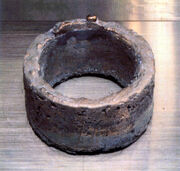
A weapons-grade ring of electrorefined plutonium, typical of the rings refined at Los Alamos and sent to Rocky Flats for fabrication. The ring has a purity of 99.96%, weighs 5.3 kg, and is approx 11 cm in diameter. It is enough plutonium for one bomb core. The ring shape helps with criticality safety (less concentrated material).
- Plutonium is a transuranic radioactive chemical element with symbol Pu and atomic number 94. It is an actinide metal of silvery-gray appearance that tarnishes when exposed to air, and forms a dull coating when oxidized.
- Symbol: Pu
- Atomic number: 94
- Electron configuration: [Rn] 5f67s2
- Atomic mass: 244 u
- Discovered: 1940
- Melting point: 639.4 °C
- Discoverers: Joseph W. Kennedy, Glenn T. Seaborg, Edwin McMillan, Arthur Wahl
- Abundance earth’s crust: negligible
- Abundance solar system: unknown
- 2015 Cost, pure: $4000 per gram
- 2015 Cost, bulk: per 100g
Early pacemaker batteries also used tiny amounts of plutonium-238.
Plutonium-239 emits Alpha radiation and has a half life of 24,000 years. That is for the time from now to the middle of the Upper Paleolithic (or Upper Palaeolithic, Late Stone Age) era. As a heavy metal, plutonium is also toxic.
Caesium-137
Caesium or cesium is a chemical element with symbol Cs and atomic number 55. It is a soft, silvery-gold alkali metal with a melting point of 28 °C, which makes it one of only five elemental metals that are liquid at or near room temperature. Handling it makes it runny and it reacts heavly in water, large amounts of it explodes in water.
- Symbol: Cs
- Melting point: 28.44 °C
- Boiling point: 670.8 °C
- Electron configuration: [Xe] 6s1
- Atomic number: 55
- Discovered: 1860
- Atomic mass: 132.90545 u ± 2 × 10^-7 u
- Abundance earth’s crust: 3 parts per million by weight, 0.5 parts per million by moles
- Abundance solar system: 8 parts per billion by weight, 70 parts per trillion by moles
- 2015 cost, pure: $1100 per 100g
- Cost, bulk: $ per 100g
Since the 1990s, the largest application of the element has been as caesium formate for drilling fluids. It has a range of applications in the production of electricity, in electronics, and in chemistry. The radioactive isotope caesium-137 has a half-life of about 30 years and is used in medical applications, industrial gauges, and hydrology. Although the element is only mildly toxic, it is a hazardous material as a metal and its radioisotopes present a high health risk if released into the environment.
Cesium readily combines with oxygen and is used as a getter, a material that combines with and removes trace gases from vacuum tubes. Cesium is also used in atomic clocks, in photoelectric cells and as a catalyst in the hydrogenation of certain organic compounds.
Cesium - WebGL Virtual Globe and Map Engine was named afer the metal, not made from it. Thire mission is "to create the leading web-based globe and map for visualizing dynamic data".
Earthquakes ans seismology
Tidal-waves\tsunamis and toxic seas
The Dead Hand System
The Dead Hand (or "Perimeter") system built by the Soviet Union (circa mid 1970s) during the Cold War has been called a "doomsday machine" due to its fail-deadly design and nuclear capabilities (launching all missiles randomly across the world outside of Russia it's allies, thus de facto bringing about even there own destruction (sick, or what)!. Yelstin closed it down, but Putin has rengaged it according to Western media reports. Nikita Khrushchev reportedly did not agree with such a response when the theory emerged in the late 1950's since he thought it was a genocidal idea that would kill innocence neutrals and any commies who the West had not managed to conquer!
Project Pluto
Project Pluto (The Flying Crowbar) was the insane doomsday weapon America almost built. It was a Cold War SLAM missile. SLAM stands for- Supersonic Low Altitude Missile, that means that this giant, nuclear-powered beast would be screaming around at low rooftop/tree top hight, spewing poisonose radiation as it went to the place it was to blow up with it's nuke (sick, or what)!
Doomsday device
A doomsday device is a hypothetical construction first considered in the mid 1950's — usually a weapon, or collection of weapons — which could destroy all life on a planet, particularly the Earth, or destroy the planet itself, bringing "doomsday", a term used for the end of planet Earth. Most hypothetical constructions rely on the fact that hydrogen bombs can be made arbitrarily large assuming there are no concerns about delivering them to a target (see Teller–Ulam design) or that they can be "salted" with materials designed to create long-lasting and hazardous fallout (e.g., a cobalt 50 or 60 type bomb).
A salted bomb is a nuclear weapon designed to function as a radiological weapon, producing enhanced quantities of radioactive fallout, rendering a large area uninhabitable. The term is derived both from the means of their manufacture, which involves the incorporation of additional elements to a standard atomic weapon, and from the expression "to salt the earth", meaning to render an area uninhabitable for generations. The idea originated with Hungarian-American physicist Leo Szilard, in February 1950. His intent was not to propose that such a weapon be built, but to show that nuclear weapon technology would soon reach the point where it could end human life on Earth. No salted bomb has ever been atmospherically tested, and as far as is publicly known none have ever been built.
For many, the scheme epitomized the extremes of the suicidal logic behind the strategy of mutual assured destruction; the idea was famously parodied in the Stanley Kubrick film from 1964, Dr. Strangelove or: How I Learned to Stop Worrying and Love the Bomb.
Bezneve made it in the 1970's, Yelstin closed it down, but Putin has engaged it according to Western media reports. Nikita Khrushchev reportedly did not agree with such a device or devices when the theory emerged in the late 1950's since he thought it was a genocidal idea that would kill innocence neutrals and any commies who the West had not managed to conquer! Both Ike and JFK also thought such weapons were inhuman and un-American it nature.
Salted bombs
A salted bomb should not be confused with a dirty bomb, which is an ordinary chemical explosive bomb containing radioactive material which is spread over the area when the bomb explodes. A salted bomb is able by desinge to contaminate a much larger area than a dirty bomb.
Cobalt bomb
Such "salted" weapons were requested by the U.S. Air Force and seriously investigated, but not deployed. In the 1964 edition of the DOD/AEC book The Effects of Nuclear Weapons, a new section titled radiological warfare clarified the "Doomsday device" issue.
Overkill?
As with all wars there are limitations to practicality and the risk of over kill, the destruction of what is supposed to be captured and one's own forces and their allies.
| Mission chosen. | The target. | Nuke's atomic yield. | Nuke Used. | The Dead. | The Wounded. | Outer edge of 3rd degree burns. |
|---|---|---|---|---|---|---|
| Wipe out most of a major city | Broadway-Lafayette Subway Station, NY. | Russian SS-25 Topol | 800kt | 1,180,300 | 1,401,440 | 60% in to SCX South Kerny Yard, NY. |
| Destroy a major military base and support centre | Chambers Field NAS, Norfolk, VA | French TN80/81 | 300kt | 16,550 | 46,980 | Bud Metheny Baseball Facility, Old Dominion University, Norfolk, VA. |
| Completely and pointlessly annihilate Spokane, Washington, and it's out-lying suberbs like Airway Highs. | Unerhill Park, Spokane WA | Chinese Dong Fen 5 | 5mt | 170,330 | 116,030 | 25% in to Meadow Wood Golf Course |
| Destroy a major railroad marshalling yard | The SCX South Kerny Yard, NY. | Largest Indian atomic missile | 60kt | 4,540 | 54,740 | Hudson City Savings Bank, John F. Kennedy Blvd, near the junction with Jewett Ave. |
| Destroy 42nd Street Port Authority Bus Terminal, PABA bus terminal (ACE), Time Sq-42nd St station, Av/w 41st station, The Manhattan Thearter Centrer and The Times Centre. | 42nd Street Port Authority Bus Terminal, PABA bus terminal (ACE) | American Davy Crockett battle field nuke. | 20 tones | 18,590 | 11,540 | Madame Tuasudes NY, but there is a even larger radiation zone with this one and it reached Golder Mayer Sq, NY. |
| Destroy central, Ocala | Chazal Park, Ocala | N. Korean highest A-bomb blast | 10kt | 2,160 | 7,260 | Uncle Roy's Mobile Home Sales, NW 4th Ave. |
The Doomsday Clock
Since 1947, the Doomsday Clock of the Bulletin of the Atomic Scientists visualizes how far the world is from a nuclear war.
Popular culture
The threat of a nuclear holocaust plays an important role in the popular perception of nuclear weapons. It features in the security concept of mutually assured destruction (MAD) and is a common scenario in survivalism. Nuclear holocaust is a common feature in literature, online sites and film, especially in speculative genres such as science fiction, dystopian and post-apocalyptic fiction.
Also see- these 3 wikis for an interesting alternate history stories about the event.
- http://althistory.wikia.com/wiki/Doomsday_%281983%3A_Doomsday%29
- http://alternate-future.wikia.com/wiki/1995_Armengeddon
- http://implausablealternatehistory.wikia.com/wiki/1962:_The_Apocalypse
Videos
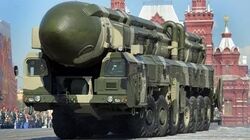
World War 3 Russia conducts surprise Large Scale Snap Nuclear Attack Drill (Oct 31, 2013)
World War 3: Russia conducts surprise Large Scale Snap Nuclear Attack Drill (Oct 31, 2013).
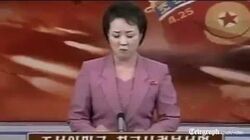
NUCLEAR-WAR---N-Korea-ARTILLERY-n-strategic-MISSILE-forces-on-ALERT-to-ATTACK-US-targets- WW3
NUCLEAR-WAR---N-Korea-ARTILLERY-n-strategic-MISSILE-forces-on-ALERT-to-ATTACK-US-targets-[WW3].

Soviet Union destroys North America (Nuclear War) - clip from the 1977 film
Soviet Union destroys North America (Nuclear War) - clip from the 1977 film.

Atomic Alert A Real Attack
The propaganda film "Atomic Alert: A Real Attack".

Atomic Attack (1950)
Atomic Attack (1950).

Nuclear Attack Strike On The U.K. Scenario (Not For The Squeamish)-0
Nuclear Attack Strike On The U.K. Scenario (Not For The Squeamish).
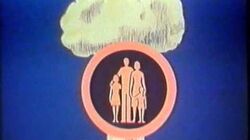
Protect & Survive - 1970's UK Public infommercials On Nuclear War Preparation
Protect & Survive - 1970's UK Public infommercials On Nuclear War Preparation.
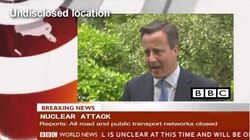
Nuke prank UK HD
Nuke prank UK HD by You Tube user The Volvic3 Project.

THERMONUCLEAR WARFARE U.S. Nuclear Retaliation Scenario (720p)
THERMONUCLEAR WARFARE: U.S. Nuclear Retaliation Scenario (720p).
Also see
- Hack Green
- Four-minute warning
- 1966 Palomares B-52 crash
- 1961 Goldsboro B-52 crash
- Operation Chrome Dome
- Thule Air Base, Greenland
- MAD
- 1961 Yuba City B-52 crash
- 1964 Savage Mountain B-52 crash
- Americas' nucliar targets in 1959
- Americas' nuclear targets in 1959
- Duck and cover
- Hack Green Secret Nuclear Bunker
- Cuban Missile Chrisis
- The atomic artillery peace ‘Atomic Annie’
- 1960 Bomarc Missile accident
- Operation Chrome Dome
- B-52 Stratofortress bomber
- Johnston Atoll
- Korean War
- UK war time regional seats of government
- Nevada Test and Training Range
- Ike
- Bikini Atoll
- CND
- Titan II Missile
- DEFCON 1
- HANDEL
- CONELRAD
- Cuban Missile Crisis
- EMP
- Electromagnetic Pulse (EMP)
- Mushroom cloud
- Comprehensive Test Ban Treaty
- Germany's Fulda Gap
- The atomic artillery peace ‘Atomic Annie’
- 1960 Bomarc Missile accident
- Operation Chrome Dome
- B-52 Stratofortress bomber
- Johnston Atoll
- Woomara test range
- Atomic War
- Three Mile Island accident
- 1968 Thule Air Base B-52 crash
- 1963 Test Ban Treaty
- Atomic warfare information notes.
- USA
- Bikini Atoll
- CND
- USSR
- Exercise Able Archer '83
- DEFCON 1
- How to say "Polaris"
- Germany's Fulda Gap
- Exercise Reforger
- Exercise Dnepr 1967
- Nukes
- Davy Crockett Weapon System
- Communist old guard
- Greenham Air Base
- 1961 Goldsboro B-52 crash
- Tsar Bomba
- Exercise Able Archer '83
- Exercise Zapad-81
- Operation Chrome Dome
- Operation Square Leg (1980) and Exercise Hard Rock (1982)
- A surprise nuclear attack
Outside links and sources
- http://www.chemicool.com/elements/nickel.html
- http://www.medicalnewstoday.com/articles/58088.php
- http://education.jlab.org/itselemental/ele084.html
- https://en.wikipedia.org/wiki/Poisoning_of_Alexander_Litvinenko
- https://en.wikipedia.org/wiki/Polonium
- https://en.wikipedia.org/wiki/Poisoning_of_Alexander_Litvinenko
- http://www.bbc.co.uk/news/health-33717184
- http://www.telegraph.co.uk/news/uknews/law-and-order/12111319/Litvinenko-Inquiry-What-is-Polonium-210.html
- https://en.wikipedia.org/wiki/Plutonium
- http://www.livescience.com/39871-facts-about-plutonium.html
- http://www.bbc.co.uk/news/world-asia-35534995
- http://www.reuters.com/article/us-northkorea-nuclear-usa-plutonium-idUSKCN0VI1WV
- http://edition.cnn.com/2016/02/10/asia/north-korea-weapons/
- http://www.world-nuclear.org/information-library/nuclear-fuel-cycle/fuel-recycling/plutonium.aspx
- http://education.jlab.org/itselemental/ele055.html
- https://en.wikipedia.org/wiki/Caesium
- https://cesiumjs.org/
- http://www.lenntech.com/periodic/elements/cs.htm
- https://en.wikipedia.org/wiki/Caesium
- https://cesiumjs.org/
- https://cesium.agi.com/
- http://www.chemicool.com/elements/cesium.html
- http://www.chemicool.com/elements/polonium.html
- http://www.chemicool.com/elements/plutonium.html
- http://www.chemicool.com/elements/uranium.html
- http://www.chemicool.com/elements/gold.html
- http://www.chemicool.com/elements/cobalt.html
- http://www.thefreedictionary.com/holocaust
- https://en.wikipedia.org/wiki/Dirty_bomb
- http://www.wikiwand.com/en/Haze
- https://en.wikipedia.org/wiki/Nuclear_winter
- https://en.wikipedia.org/w/index.php?title=Nuclear_darkness&redirect=no
- http://www.agu.org/meetings/fm06/fm06-sessions/fm06_U14A.html
- http://www.eoearth.org/article/Nuclear_winter
- http://www.atomicarchive.com/Movies/Movie6.shtml
- http://climate.envsci.rutgers.edu/nuclear
- http://envsci.rutgers.edu/~robock
- http://climate.envsci.rutgers.edu/nuclear/
- http://babel.hathitrust.org/cgi/pt?id=uc1.31822020694212;view=1up;seq=11
- The Encyclopedia of Earth, Nuclear Winter
- http://althistory.wikia.com/wiki/Climate_%281983:_Doomsday%29
- http://www3.wooster.edu/history/jgates/book-h11.html
- http://acd.ucar.edu/~mmills/pdf/2008MillsPNAS_MassiveOzoneLoss.pdf
- http://www.sciencedaily.com/releases/2006/12/061211090729.htm
- http://climate.envsci.rutgers.edu/nuclear/
- https://en.wikipedia.org/wiki/Nuclear_winter#Consequences
- http://www.infoplease.com/encyclopedia/history/hydrogen-bomb.html
- https://en.wikipedia.org/wiki/Thermonuclear_weapon
- http://news.sky.com/story/1635065/japan-threatens-to-shoot-down-north-korea-rocket
- http://www.slate.com/articles/life/the_spectator/2007/08/the_return_of_the_doomsday_machine.html
- https://books.google.co.uk/books?id=0v0dAwAAQBAJ&pg=PA407&lpg=PA407&dq=doomsday+bomb+slate&source=bl&ots=9Xyj3GgnLF&sig=hBiDKjOs3CNaBw7UvodRCwPr5fg&hl=en&sa=X&ved=0ahUKEwjut-zAj93KAhXJthQKHaxDAmgQ6AEILzAD#v=onepage&q=doomsday%20bomb%20slate&f=false
- http://jalopnik.com/the-flying-crowbar-the-insane-doomsday-weapon-america-1435286216
- http://www.rense.com/general40/dooms.htm
- Nuclear Winter Simulation Animation
- New studies of climatic consequences of regional nuclear conflict
- The Encyclopedia of Earth, Nuclear Winter
- Nuclear Winter Simulation Animation
- New studies of climatic consequences of regional nuclear conflict
- Alan Robock,
- http://jalopnik.com/the-flying-crowbar-the-insane-doomsday-weapon-america-1435286216
- http://www.rense.com/general40/dooms.htm
- https://web.archive.org/20141006085234/
- http://www.agu.org/meetings/fm06/fm06-sessions/fm06_U14A.html
- http://climate.envsci.rutgers.edu/pdf/RobockNW2006JD008235.pdf
- http://climate.envsci.rutgers.edu/nuclear/
- https://en.wikipedia.org/wiki/Solar_irradiance
- https://en.wikipedia.org/wiki/Doomsday_device
- http://www.wired.com/2007/09/soviet-doomsday/
- http://www.slate.com/articles/life/the_spectator/2007/08the_return_of_the_doomsday_machine.html
- http://books.google.com/?id=JelgwgVx-P0C&pg=PA75&dq=%22leo+szilard%22+salted+cobalt+nuclear+life&cd=1#v=onepage&q=&f=false
- http://nuclearweaponarchive.org/
- Samuel Glasstone, The Effects of Nuclear Weapons, 1962, Revised 1964, U.S. Dept of Defense and U.S. Dept of Energy, pp.464–5. This section was removed from later editions, but, according to Glasstone in 1978, not because it was inaccurate or because the weapons had changed.
- https://en.wikipedia.org/wiki/Radiation_damage
- https://en.wikipedia.org/wiki/Ionizing_radiation
- http://www.who.int/ionizing_radiation/about/what_is_ir/en/
- ICRP publication 103 paragraph 55